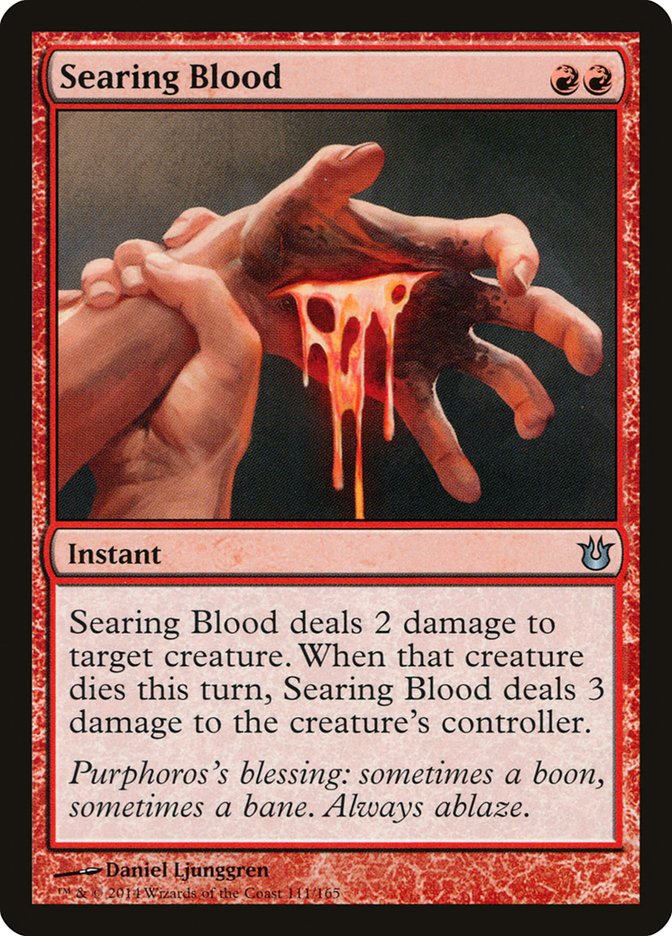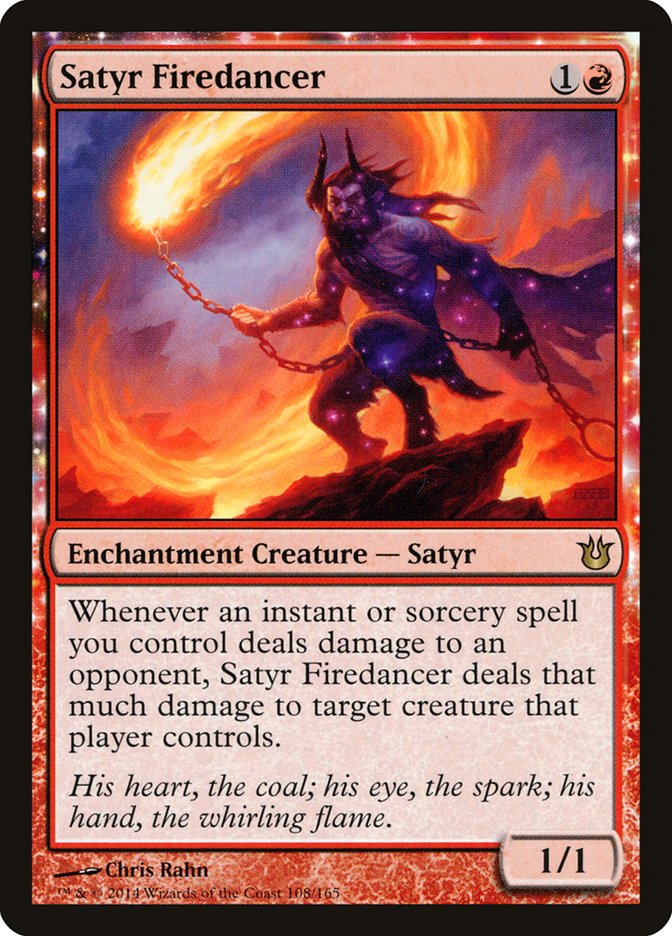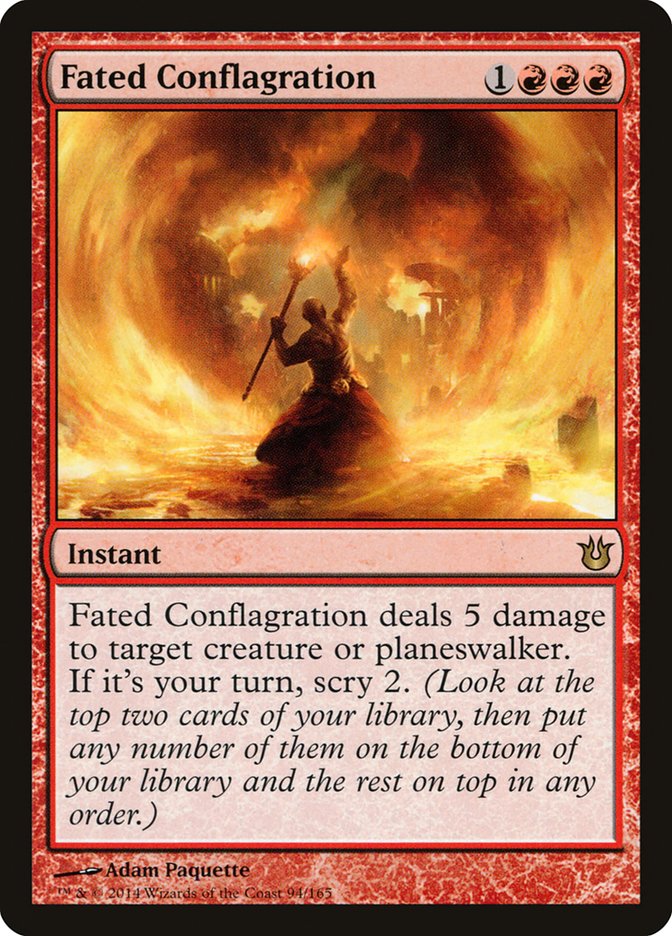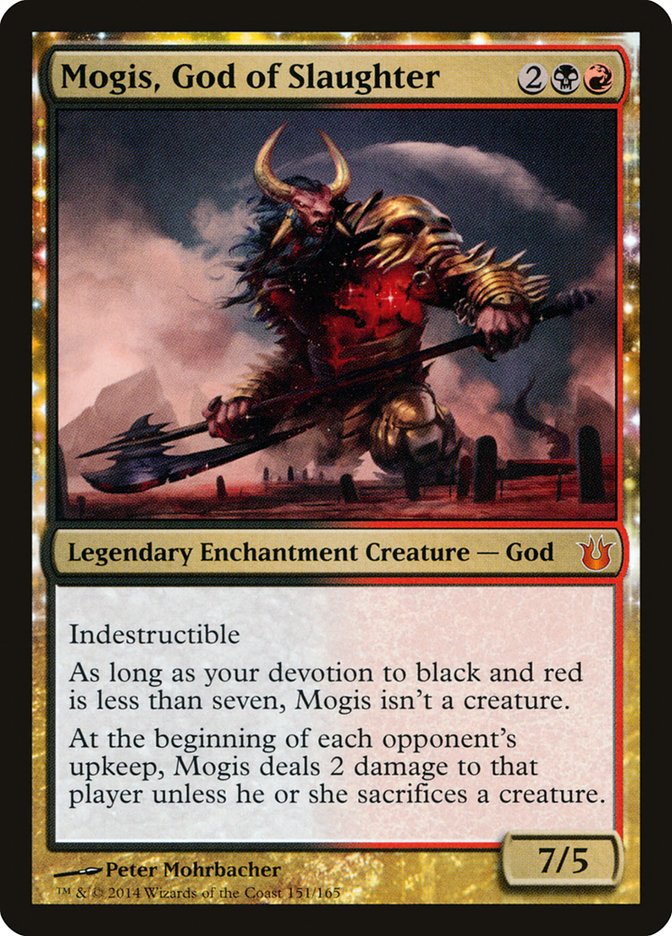The Prerelease of Born of the Gods was the past weekend, but I didn’t compete. Life on the road has been taxing, and I wanted to use my first weekend off in 2014 to do some explicitly non-Magic stuff. That said, I dropped by Sky High Comics in San Marcos, California (my local spot) to watch and halfheartedly cheer on my friends, and it looked like everyone was having a good time. I like tribute and inspired a lot as keywords for Limited play; they both have a lot of play to them without being excessively complicated from a rules standpoint. I’m very excited to start drafting the set once it becomes available on Magic Online.
Given the lull in the SCG Open Series and a fresh new set, it seems like a good time to do a Red Box Review for Born of the Gods. For those of you unaware, I have a large box with all the "reasonable" tournament-level red cards that I bring around to events and build decks out of. It’s sorted alphabetically by card type (dudes, burn, Stone Rains, random utility, etc.) so it’s never hard to find that Spinal Villain or Guerrilla Tactics I might need to round out a Legacy sideboard, and maintaining this box (there is only so much room for additional content, after all, and it seems against the spirit of the whole thing to have a second "Red Box") is something of a labor of love.
I used to do a Red Box Review for every set, but I stopped after one very shallow set (M11 or M12 maybe?) and then some resentment about being typecast Frank Vincent style into one kind of role. But at this point, who are we kidding? I am who I am. Also, the articles were more popular than I thought, and I feel like I owe the community some positive vibes after last week’s pessimistic take on Standard. After all, there’s a new set, plenty of the cards are good, and some of those cards happen to be red. No reason to rain on everyone’s parade with "The End Is Nigh" street corner sermons about how your New Favorite Card is just going to get Thoughtseized away (you big dummy).
Before we dive in, here’s a quick aside on the Modern bannings. In short, my reaction is "sure, whatever." I’m very pro Nacatl, awash with apathy over Bitterblossom (if Faeries is the best deck, it’s a big net negative for the player base overall, but the power level of the deck is probably tolerable compared to the best stuff going on and I don’t mind kicking the tires on non-combo cards on occasion), and negative toward Deathrite Shaman since it is a theoretically honest Magic card distorted by the fetch lands, which are the biggest systemic problem in the format.
Every time a card with text is banned because of fetch lands, I get very agitated, so the Nacatl/Shaman swap is close to neutral in my mind. Nacatl is more about honest Magic than Deathrite Shaman (which is also pretty honest as far as very powerful cards go), so I guess I would rather have the Cat Warrior legal if I had to choose between the two.
That’s the thing—I’m not sure if we have to choose between the two because the goals and process for the banned list is still a mystery, and that’s my biggest gripe. Maybe that’s the point though. Obfuscating how and why cards get banned leads to a lot less predictability and excitement when things get unbanned, and there’s something to be said for that. Still, Modern stands as a contrast to the style implemented with the rest of Constructed.
Modern is being "managed" by the banned list far more aggressively than other formats, which might be a necessity for a format that’s supposed to be both "Eternal" and "a PTQ format." Still, the overall power level of the format is such that new impactful content can regularly be released in Standard-legal sets without messing up that format (as opposed to Legacy, where regularly trying to compete with Brainstorm and Wasteland would be a disaster), and I wish Wizards was a bit more aggressive about going down that road instead of the banned list. It’s more exciting to give players new toys than take away old ones, after all, and engendering some consumer confidence is always a nice thing when the cost of decks is quite high (and likely to get higher over time).
In the end, two cards came off, and only one card was added, so I guess that’s something. I just still have my doubts that a format managed so aggressively by bannings will ever resonate with the overall player base, especially when so many actual or potential offenders are immune for "political" reasons (fetch lands and Tarmogoyf most notably, with some other stuff down the list).
The question is ultimately "is engineered and explicit management of the format in the name of diversity something that players find fun or annoying? Fresh or patchy? Do players not really care about cards being taken away for seemingly random reasons as long as there are a variety of decks to play?" Of course there are players in both camps, but I fear the chosen path will only appeal to Magic’s most devoted fraction of players over time. PTQ and GP attendance will ultimately bear this out, and I would be happy to be proven wrong here.
Searing Blood
This is by some margin the most powerful card for aggressive red strategies in the set, but it’s not a freebie. The closest comparison is Searing Blaze, of course, but there a couple of important distinctions.
1. The creature actually has to die, so you can’t just go snapping this off on Tarmogoyfs and Baneslayers to finish off your opponent. Because of this, the specifics of creatures people play matters a lot.
2. Unlike the very oddly worded Searing Blaze, Searing Blood only targets creatures, so it’s a bit weaker to sac outlets, bounce spells, and the like.
With that said, the upside here is enormous. Searing Blaze is a card I’ve won quite a bit with in a format as powerful as Legacy, and this isn’t that far off (and actually better in a few spots). So the questions are "can we maindeck this in Standard?" and "what is the best shell to maximize this?"
To the first question, I think the answer is certainly "yes" as long as Mutavault remains in heavy rotation. Mutavault alone doesn’t make Searing Blood okay to maindeck, but given the number of good targets in addition (Pack Rat, various blue devotion creatures, Precinct Captain, etc.), it seems fine to play given where the metagame currently is. Even a deck like U/W Control plays Elspeth, Sun’s Champion alongside Mutavault.
Now with that answered, what kind of deck do we want to play it in? Much like Searing Blaze, in the most aggressive shell possible. Most quality cards against such a deck are going to be cheap creatures, and your win rate when you Blaze/Blood your opponent’s first play is sky high assuming you have anything to complement it. Consider the following list:
Creatures (30)
Spells (30)
Sideboard

This is the Standard decklist I’ve been playing on Magic Online for the last month or so, with Searing Blood replacing Dynacharge (which has also been Titan’s Strength or Rubblebelt Maaka at various points). It’s easy to see how much raw power gets added to the deck by making a substitution like that, and Searing Blood also happens to play well with Legion Loyalist in the same way (first strike and Blood play very nicely together).
Wizards seems pretty committed to giving red aggro at least one reasonable obvious card per set. Stromkirk Noble, Ash Zealot, Firedrinker Satyr, and others all exist to keep the dream alive even though the deck is rarely a heavy factor in the Standard metagame. Searing Blood could potentially change that, as it is substantially more powerful than the other cards that I just mentioned (which are no slouches themselves) assuming metagame conditions are appropriate. As long as Mutavault and small creatures remain a healthy portion of Standard, this card provides a very strong incentive to explore aggressive red strategies. In Modern, I expect this card to potentially supplement Searing Blaze as a sideboard card for decks like Affinity and Birthing Pod.
Flame-Wreathed Phoenix
Good old punisher. Flavored as "tribute" this time around, this type of card is misunderstood by two classes of players. For lower-level players, these cards often appear as "two good deals," which ignores that your opponent gets to choose which deal you get (and normally one of the two deals isn’t actually very good in a given game state). For more experienced players, there’s often a viscerally negative reaction to anything that gives your opponent choices. This isn’t a bad reaction on the surface, but there are often situations where neither option is good for the opposing player and the "two good deals" ideal can manifest. I tend to evaluate these cards using two metrics:
1. Are both sides of the card "priced to move?" Your Ancestral Recall punisher card isn’t doing very much work for you if the other side is Mudhole because then you just get Mudhole.
2. How different are the halves from one another? The more similar they are, the more likely it is that your opponent will have no good choice (assuming you’ve sculpted your deck to maximize the situation). The more different they are, the more likely your opponent will have a good option afforded to them even if both rates are good on the surface.
By these metrics, it’s no surprise that Vexing Devil and Browbeat have seen the most tournament play. They have pretty similar halves (Vexing Devil is quite similar a lot of the time, and the cards one would draw from Browbeat just get converted into damage assuming the deck is built appropriately), and both have very good rates on both sides.
On the first test, Flame-Wreathed Phoenix scores very well. A 5/5 flyer for four is still a great deal even by modern standards. I’ve played Rathi Dragon and Fledgling Dragon at various points, and I would’ve played a blank version of those cards at various points over the last decade if it were allowed. A 3/3 haste unkillable flyer for four would’ve also been a sideboard staple for me, at least doing work against other red decks or decks with a ton of removal.
How about the second test? This is where the Phoenix scores poorly. Sometimes a 3/3 body just doesn’t do enough for four mana, and sometimes your opponent will have a removal spell for your big 5/5 flyer. Phoenix is the worst-case scenario in both instances, and these aren’t exactly uncommon scenarios. So where does this card fit in?
We’ve already established that the best thing to do is make both options bad for your opponent. This can be done with the way you’ve built your deck or the way your opponent’s deck is set up. To the first point, powering out this card quickly can be quite good. We haven’t seen a punisher creature that is this expensive and this powerful, so this is uncharted territory. It’s possible this could be incorporated in a deck like G/R Monsters or other decks utilizing mana acceleration.
As far as the second part goes, there are plenty of decks that aren’t well equipped to handle either side, and the Phoenix has the potential to be good against those opponents as well. Red aggro, G/R Monsters, and various green creature decks aren’t full of great answers to either half, nor is there a half that they can ignore, so I believe this card has the capability of being a great sideboard card against a variety of opponents if nothing else.
Satyr Firedancer
This one is going to be quick—as far as Standard is concerned, there’s almost nothing to see here. There simply isn’t a density of cheap powerful Lava Spikes to build around this. Once we start talking about Modern, things get interesting. This card is too narrow in scope to be considered for the maindeck, but it does have potential against decks that are crammed full of cheap creatures and don’t have much in the way of removal.
Think of decks like Affinity, Soul Sisters, Merfolk, and the like. You have to use your burn to kill opposing creatures in these matchups some amount of the time, and that can leave you short of generating lethal. Firedancer has the potential to be the best of both worlds if left unopposed, as you can send everything at your opponent while doing appreciable damage to their board, and there’s no shortage of quality Spikes and Bumps to choose from.
Fated Conflagration
A workmanlike staple. This kills Jace, Architect of Thought and Polukranos, World Eater for equivalent mana and a little value if you can afford to play it as a sorcery. Since those are two of the toughest cards for red decks to deal with in current Standard, there’s a good chance this has a home somewhere. A little expensive for my tastes, but gets the job done if you’re playing enough mana.
Mogis, God of Slaughter
Xenagos, God of Revels has received the most attention of the new Gods, and it’s currently the most expensive on StarCityGames.com, indicating that the community is getting behind it. For me, Mogis is where it’s at. While Xenagos potentially fits as a one- or two-of in a deck like G/R Monsters, Mogis can be a four-of build-around card for a new deck. There’s no denying the power level—it’s very close to a one-sided Sulfuric Vortex in a lot of spots, and turning on devotion is a possible and powerful thing to do.
Even though it is a gold devotion card, Mogis is asking for a monocolored creature base if we care about devotion at all. This is because of the nature of the card. Mogis is best served in a beatdown deck, so we naturally have to bias our mana in one direction to cast our cheap spells on time. If we try to play a mixture of black and red threats, we probably have to play a bunch of colorless mana symbols on our permanents as a concession to our mana base, and that doesn’t seem like a good foundation to me.
So how about we take a page from the red devotion creature base but make it a little more aggressive to better capitalize on Mogis? A starting point:
Creatures (27)
- 4 Chandra's Phoenix
- 4 Rakdos Shred-Freak
- 4 Ash Zealot
- 4 Rakdos Cackler
- 4 Boros Reckoner
- 4 Firedrinker Satyr
- 3 Mogis, God of Slaughter
Lands (10)
Spells (25)
Sideboard

This is a very rough sketch, but the core concepts are here. As I’m prone to do, I erred on the side of extreme caution with the mana base, but it’s possible that a copy or two of Mutavault could sneak its way in here. Also, I believe there’s enough black mana in the maindeck to incorporate other black cards alongside Mogis is you feel like Doom Blade or Ultimate Price is more appropriate for your metagame (Master of Waves is a challenge for the deck as currently constructed). I feel like you want to have a reasonable amount of removal in the maindeck since all you want to do is keep the board clean for Mogis, so I wouldn’t cut removal out of the deck altogether.
Hopefully the idea is obvious enough—get on the board fast so Mogis is threatening meaningful damage, play enough removal so your opponent doesn’t have enough little dorks to sacrifice to Mogis, and play with a lot of colored mana symbols so Mogis’s devotion gets incidentally turned on. The last thing is easier than it looks—Boros Reckoner + a two-mana creature gets the job done, and the threat of Mogis cracking for seven will contort your opponent’s play even if you aren’t able to do it.
If you’re a red mage, there’s a lot to like in Born of the Gods. Searing Blood is about as good as it gets for a "pups and bolts" strategy, Mogis is one of the more enticing build-around cards I’ve seen in a while, and there’s some reasonable depth as well. In spite of my dour take on current Standard, I’m excited to get brewing, as red has some structural advantages against some of the top decks and is receiving a healthy injection of power in Born of the Gods. Happy brewing.





